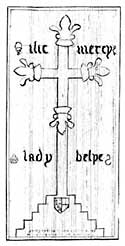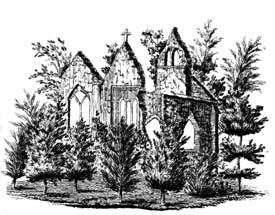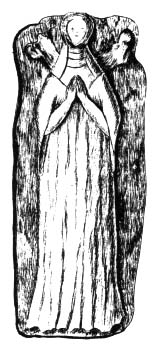H A U G H T O N.
 |
| Fig 1. |
THE duke of Newcastle proprietor, enclosed. This domain was once the abode of the Stanhopes, and afterwards that of the Holles’, but now the dwelling is in total decay. Haughton, now, as a place of residence, is known by a house or two, and a paper—mill. Of what it has been, we learn by an article inserted in Gervase Holles’s MSS. collections for the county of Lincoln. now in the British museum:--
"Haughton neare Tuxford, Nottinghamshire,
"This mannour gives the title of baron to the present erles of Clare. It is seated on the verge of the forest of Shirewood, and therefore more triumphes in pleasantnesse, then richnesse of soyl, and yet the best part of it is not unfertile, it is very well watered, the river Idle running quite through it (as a lesser brooke doeth in another part) encompassing the house rounde about in its passage. The house it self is an old building with little uniformity in it, as being built att severall tymes. The oldest part of it is the tower at the entrance; (as it should appeare by some escocheons cut in stone on the north sides of it and south,) built by some of the family of Langvillers, or of Stanhope (for that family for a time bore Langvillers armes for their owne paternal coate.) The escocheons on the south are these underneath.
It appears that the hall was built by the last Sir William Holles, as appears by this ensueing, which is carved in stone on either side the entrance doore, and expresses the yeare of the lord, his name and rebus.
On the right hande, is a mans hand holding a vine branch loaded with fruit, upon which is a shield inscribed thus W. H. Ao Di. 1545.*
* "In his memoirs of the Holles family in Coll. P. 67. He says " The tower of this house (I probably conjecture) was built by John Stanhope great grandchild of that John, who married Maulovel's heir. This I gather from the escotcheons of the arms cut in stone towards the top of this tower, where is that of Longvillers several times, namely a a bend between 6 cross croslets, which the family of Stanhope bore for several descents as their own parternal coat, as I have seen both upon their seats and monuments. This tower, and the southside of the house I not unlikely conceive this John Stanhope built, but the hall was erected by Sir William Holles, as is apparent by the letters carved in stone over the hall chimney; and more plainly by the entrance from the court into the hall, where on either side is engraven W. H. A. D. 1545."
On the left is a similar one transversed."
The following is from a tour, in 1787, from London to the western highlands:—
"All the great estate of the duke of Newcastle in the parts, (speaking of Clumber) came by his wife, the daughter of Henry Pelham, from the Holles’s, earls of Clare: but this was not their seat, at least not the principal; if any thing, probably a lodge. Haughton, in this neighbourhood, was their mansion, which was bought of the Stanhope’s by sir William Holles, a great merchant, and lord mayor of London, in the reign of Henry the 8th, who lest an estate to his eldest son, which was worth 10,000l. per annum, in the above reign. What an enormous estate for that time! Sir William, the son, lived at Haughton, in great splendor and hospitality. "He began his christmas, at All-hollow-tide, and continued it until candlemas, during which any man was permitted to stay three days, without being asked whence he came or what he was." His son dying before his father, never came to the family estate, but lived at Irby, in Lincolnshire, " where he was seen many times to confront Henry Clinton, earl of Lincoln, who was a great tyrant amongst the gentry of that country, and carry business against him, as it were, in despite of his teeth." How little he thought, that his estates and his blood would centre in the heir of this tyrannical earl, which the duke of Newcastle is! The 4th and last earl of Clare married the coheiress of H. Cavendish, duke of Newcastle, and was himself, after the death of his father-in-law, in 1691, created duke by that title; his own eslate, and the Cavendish together, amounting to 40,0001. per annum. Haughton, upon the acquisition of these estates, was probably neglected, if not already in ruins, and the duke resided at Welbeck Abbey. Afterwards, when the Holles and the Cavendish eslates came to separate again, and the latter went through the Harleys, to the Bentnicks, a mansion probably was wanted for the former, and Clumber Park, which might be a lodge before, was by degrees extended to its present size and importance."
 |
| Fig 2. |
Near the park-gate of Haughton was erected, in 1692, a free school, for the benefit of those of this place, Bothamsall, Elksey, Gamston, West Drayton, Milton, and Bevercotes.
This school was endowed with 27l. per annum, by Mr. Henry Walters, steward to Gilbert and John earls of Clare. He also gave 20l. per annum for the maintenance of four minister’s widows, 5l. each.
HAUGHTON CHAPEL,
I found a little pleasing ruin, surrounded by a young plantation of trees; a sketch of which, in its present slate, is subjoined, figure 2. This chapel seems originally built in an old stile of church building, many parts, it is visible, has been altered or repaired since its original erection. It had, by what is visible at present, only a nave and north cemetery, or burial place; the presinae at the east end is discoverable. In the chapel is an old floor-stone with a cross, see figure 1, same plate, "Jesu mercy. Lady Helpe," under the arms "Orate pro aia Johanne Stanhope uxor Henrici Stanhope Arm. &c."
The male arms on this stone are those of Longviller, borne, at that time, by the family of Stanhope. Henry Stanhope, younger son of John Stanhope, Com. Nott. in the reigns of Henry 6th and Edward 4th, married Joan, daughter of Henry Rochford, of Stoke Rochford, Com. Lincoln. whose monumental stone, probably this is … The female, are much injured.
 |
| Fig 3. |
In Hollie’s MSS. above recited we have the following respecting this chapel –
"North by the side of this gravestone (Stanhopes) lyes buryed the body of Sir Wm. Hollys, knight, qui obiit, 18 Jan. Anno Dom. 1590. And Anne his first wife, daughter and coheire of John Densell of Densel in the county of Cornewall, serjeant at law; and Jane his seconde wife, daughter of Sir Richard Grosvenour, knight, which Jane dyed without issue."
On the outside of the chapell close by the north wall lies the portrayture of a lady elegantly carved in freestone, her head supported by an angell, at her feete –– No inscriptions.
In the porch two other portraytures without inscriptions; they doe seem by their habitts to have been chaplaynes.
On the outside of this chapel, amid some rubbish and nettles, lies the figure of a lady, much mutilated. This lump of stone, which once was sheltered within this little sanctuary and for ages, perhaps, carefully preserved lies now buffeted by the weather, in a comfortless and solitary abode. It had a cherub on either side its head: See fig. 3. Probably that mentioned above by Hollis.
